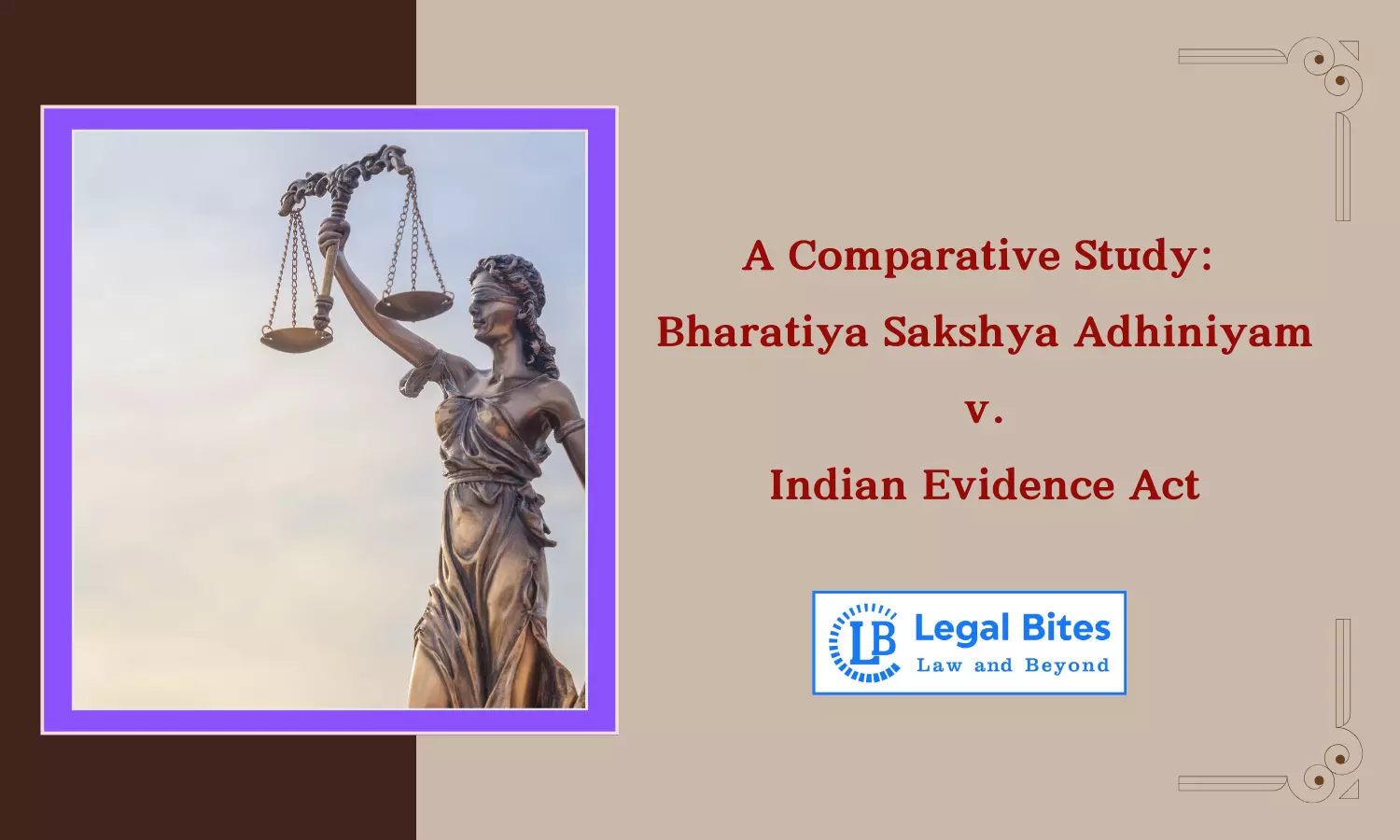A Comparative Study Between Bharatiya Sakshya Adhiniyam v. Indian Evidence Act
This study compares Bharatiya Sakshya Adhiniyam and the Indian Evidence Act, exploring their roles in regulating evidence in the Indian legal system.

This study compares Bharatiya Sakshya Adhiniyam and the Indian Evidence Act, exploring their roles in regulating evidence in the Indian legal system.
Introduction
Indian Evidence Act, 1872 has been replaced by the Bharatiya Sakshya Adhiniyam, 2023 as a part of the restructuring of criminal laws. The Bharatiya Sakshya Bill, 2023 was introduced on August 11, 2023, in the Lok Sabha and the same accompanied the Bharatiya Nyaya Sanhita, Bharatiya Nagrik Suraksha Sanhita which are the other two laws replacing the Indian Penal Code and the Criminal Procedure Code.
The implementation of the Indian Evidence Act, 1872 itself was a groundbreaking step by the government which changed the whole process of admissibility of evidence in the Indian Courts. It is also important to note that the year when the old Indian Evidence Act came into being, India was under British rule.
This proves that a major part of the said law was influenced by the circumstances prevailing in the country then and the objectives that the then-British government wanted to achieve. The introduction of the new criminal laws by our Current Minister of Home Affairs depicts the necessity to move towards a new and modern India based on evolved objectives sought to be achieved via the criminal justice system.
The Bharatiya Sakshya (Second) Bill, 2023, was passed by the Lok Sabha on December 20, 2023. It was approved by the Rajya Sabha on December 21. The bill received President Droupadi Murmu’s assent on December 25, 2023 and thus, the same became an Act which then came to be known as Bharatiya Sakshya Adhiniyam, 2023, or Bharatiya Sakshya Act, 2023.
This article attempts to create a comparison between the Bharatiya Sakshya Adhiniyam, 2023, or Bharatiya Sakshya Act, 2023 and Indian Evidence Act, 1872 to understand what are the new additions, omissions, and other changes as introduced in the new Act and how the same is set to bring about changes in the evolved criminal justice system of modern and new India.
Framework of the Bharatiya Sakshya Adhiniyam, 2023, or Bharatiya Sakshya Act, 2023
Let us understand the basic differences between the Bharatiya Sakshya Adhiniyam, 2023 and the Indian Evidence Act, 1872 as per their framework:
Bharatiya Sakshya Adhiniyam, 2023 | Indian Evidence Act, 1872 |
170 Sections in Total | 167 Sections in Total |
The following information is about the Bharatiya Sakshya Adhiniyam, 2023 in comparison to the Indian Evidence Act, 1872:
| 1. | Modification in Section(s) | 23 |
| 2. | Repealed Section(s) | 5 |
| 3. | Newly Added Section(s) | 1 |
The Bharatiya Sakshya Adhiniyam, 2023 has retained certain provisions as formed part of the Indian Evidence Act, 1872 and some of those include provisions on the burden of proof, confessions and admissibility and relevancy of facts.
The major change sought to be inculcated in the new law is the inclusion of technological advancements, and changes in society as compared to the time when the Indian Evidence Act, 1872 was implemented
A Comparative Analysis: Bharatiya Sakshya Adhiniyam, 2023 v. Indian Evidence Act, 1872
Let us first discuss some of the major provisions that have been retained by the Bharatiya Sakshya Adhiniyam, 2023 as were present in the Indian Evidence Act, 1872.
1. Proven Fact - Provisions for ‘proven fact’ states that any fact shall be considered to have been proven if and when the Court believes that it exists, or that its existence is of the manner that any prudent man must be acting as if it has been into existence in the present case’s circumstances.
2. Police Confession - The provisions which mention ‘police confession’ state that any confessions that are made to the police are not admissible. In general circumstances, it is inadmissible but shall be admissible in cases where the Magistrate has recorded it.
3. Admissible Evidence - The parties which are thereby involved in a legal proceeding are permitted by law to only submit admissible evidence. This category of ‘admissible evidence’ can further be divided into ‘facts in issue’ and ‘relevant facts’.
- Facts in Issue - Such facts which determine the existence, nature, or extent of any right, liability, or disability claimed or denied in a legal proceeding.
- Relevant Facts - These are the facts which are pertinent to the case at hand. The same as provided by the Indian Evidence Act, 1872 are of 2 types- documentary and oral evidence.
Let us now discuss some of the major provisions that present the key changes that have been introduced in the Bharatiya Sakshya Adhiniyam, 2023 in comparison to the Indian Evidence Act, 1872.
Section 2 of the Bharatiya Sakshya Adhiniyam, 2023 has modified the definition of the term ‘document’ by way of including electronic and digital records.
The illustration that has thus been added to the provision is as follows: "An electronic record on emails, server logs, documents on computers, laptop or smartphone, messages, websites, locational evidence, and voice mail messages stored on digital devices"
The new law allows oral evidence to be given electronically as well. This is a major change as the previous evidence law did not provide for this option and it defined oral evidence to be statements that the court has permitted to be taken into the record by witnesses for matters under inquiry.
Section 22A of the Indian Evidence Act, 1872 which dealt with the oral evidence as regards to contents of electronic records has been excluded from the new law.
Section 22 of the Bharatiya Sakshya Adhiniyam, 2023 has altered the need for ‘confessional admissions’. It states:
A confession made by an accused person is irrelevant in a criminal proceeding if the making of the confession appears to the Court to have been caused by any inducement, threat, coercion, or promise having reference to the charge against the accused person, proceeding from a person in authority and sufficient, in the opinion of the Court, to give the accused person grounds which would appear to him reasonable for supposing that by making it he would gain any advantage or avoid any evil of a temporal nature in reference to the proceedings against him.
Section 57 of the Bharatiya Sakshya Adhiniyam, 2023 has well recognized the inclusion of electronic and digital records to be considered as primary evidence.
Section 58 of the Bharatiya Sakshya Adhiniyam, 2023 has amended Section 63 of the Indian Evidence Act, 1872 by expanding the scope of secondary evidence.
Certain categories have been added in addition to the existing ones to broaden the said scope. The new categories now include:
“Oral admissions, written submissions, and evidence of a person who has examined a document, the original of which consists of numerous accounts or other documents which cannot conveniently be examined in Court, and who is skilled in the examination of such documents.”
Section 61 of the Bharatiya Sakshya Adhiniyam, 2023 reinforces the validity, effect and enforceability of electronic and digital records to be equivalent to other documents. Furthermore, Section 63 of the Bharatiya Sakshya Adhiniyam, 2023 further presents a certain set of types of digital and electronic records for reference in the court of law.
Section 65B of the Indian Evidence Act, 1872 which mentioned the requirement of a certificate for electronic records, has been simplified and retained along with a broad interpretation that would now hold electronic and other records on the same pedestal.
It is imperative to note that the structuring of the section about the examination of witnesses has been done differently from the provision as present in the Indian Evidence Act, 1872 but the crux remains somewhat similar. The concept of ‘leading questions’ has also been modified to omit the loophole present earlier in Section 141 of the Indian Evidence Act, 1872 as the same was ‘generic’ and ‘reliable on suggestive character’ of questions.
Conclusion
As we have discussed above, it can be well understood that along with the introduction of new provisions in the evidence law of India, another major objective behind introducing these new laws is to restructure and consolidate the provisions on similar subject matter in one place to make the laws simple, accurate and adequate. It is an attempt to foster uniformity in the criminal justice administration in India.
The idea is to promote applying similar standards to the same set of cases and subject matters. However, it is also imperative to note that the same is a huge step towards the evolution of the criminal laws of India and its efficacy and efficiency can only be examined post-implementation which is set to commence from 1st of July, 2024.
References
[1] Implementing Bharatiya Sakshya Adhiniyam, Available Here
[2] Shishir Sinha, 3 Bills to Replace Criminal Laws introduced in Lok Sabha, Available Here
[3] Bharatiya Sakshya Adhiniyam, 2023, Available Here
[4] Indian Evidence Act, 1872, Available Here
Important Links

